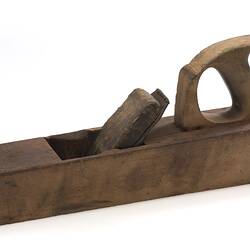Summary
Wooden tongueing plane, designed for use as a matching pair of planes with HT 12451, for producing tongue and groove joints along the matching edge for flooring or lining boards. Once owned by Joseph Stevenson, reputed to have built the first wooden house in Melbourne and the first public punt to operate on the Yarra River, for publican William Watts, near the site of the present Princes Bridge. He was also involved in the construction of Kirk's Horse Bazaar in Bourke Street and other early Melbourne buildings. Joseph Stevenson later settled at Kangaroo Ground in the 1840s.
Physical Description
For 3/16-inch groove at¼ from edge of 5/8 inch thick board. 3/4 in wide cutting iron 9 ½ in (242 mm) x 1 1/8 in (28 mm) x 5 3/4 in (145 mm)
Significance
This tool box and surviving tools belonged to the donor's great-great ?? grandfather, Joseph Stevenson, a trained carpenter & joiner, who emigrated to Australia from Aberdeen Scotland in about 1832. Stevenson arrived in Melbourne the first few years of the settlement's existence and worked as a self-employed carpenter, building amongst other structures, (reputedly) the first wooden house, the first Yarra punt for William Watts in 1838, and Kirk's Horse Bazaar at 47 Bourke Street west, where he resided for a period. Situated near the present site of Princes Bridge, Watt's rope-operated punt remained the main public crossing on the Yarra river for pedestrians, carriages and stock travelling between the city and Sandridge (Port Melbourne), St Kilda and other developing southern suburbs until the opening of a wooden toll bridge just downstream near the Falls by the Melbourne Bridge Company in 1845. It was in turn replaced by the original Princes Bridge, an elegant single-arched stone structure designed by Lennox and opened in 1850.
By the early 1840s Joseph Stevenson had taken up land at Kangaroo Ground becoming one of the first settlers in the area and first to grow vines in the area, producing some of the colonies earliest wines.
More Information
-
Collecting Areas
-
Acquisition Information
Donation from Mrs Diana Bassett-Smith, 24 Apr 2006
-
Date Used
-
Inscriptions
Stamped into leading end: "Melville/J. STEVENSON" Stamped into trailing end: :4/8".
-
Classification
-
Category
-
Discipline
-
Type of item
-
Object Measurements
24.1 cm (Length), 3.95 cm (Width), 14.3 cm (Height)
-
Maximum dimensions
240 mm (Length), 29 mm (Width), 140 mm (Height)
Measurement From Conservation.
-
References
Salaman, R. A, Dictionary of tools used in the woodworking and allied trades, c. 1700-1970, London, Allen & Unwin, 1975
-
Keywords






